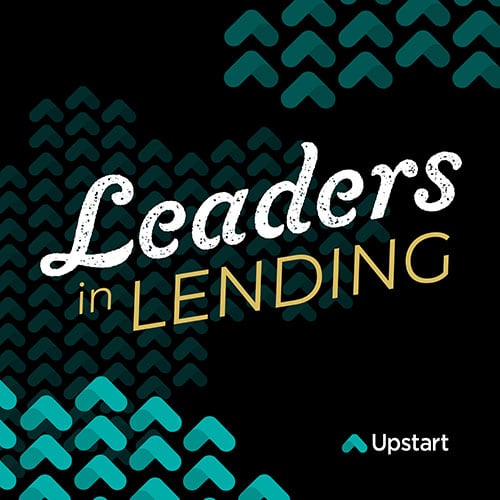With over 25 years of experience in data strategy, governance, and cloud platform transformation, Chris Gifford is a senior executive specializing in building data ecosystems that support business objectives. He has successfully led data science, applied analytics, and modeling teams across the financial services industry. Known for his expertise in delivering cloud-based data solutions and implementing information governance in line with OCC and BCBS 239 standards, Chris is a leader in transforming organizations through digital innovation, AI/ML, and big data initiatives. Currently, he serves as Chief Data and Analytics Officer at USAA Bank.
Leaders in Lending | Ep. 154
From Ledgers to Algorithms: Revolutionizing Financial Data
Chris Gifford, Chief Data and Analytics Officer at USAA Federal Savings Bank, is a prime supporter of leveraging algorithms to best serve consumers and streamline operations and has been an active participant in the evolution of data analytics within the financial industry.


GUEST SPEAKER
Chris Gifford

ABOUT
USAA Federal Savings Bank
USAA Federal Savings Bank is dedicated to serving military families by providing comprehensive insurance, banking, and retirement solutions. Founded on military values, the organization prioritizes members' financial security through competitive products and exceptional service. With over 100 years of experience, USAA continues to support active, separated, and retired military personnel and their families with a commitment to integrity and innovation. Guided by a strong leadership team, USAA remains focused on meeting the evolving needs of its members while promoting financial empowerment and community resilience.
Key Topics Covered
- The democratization of deep data analysis and its effects
- What factors organizations should consider when deciding whether to build, buy, or partner for technological solutions
- Using timely data analysis to give personalized advice to members
- Strategies for fostering a culture of innovation within data analytics teams

“We have come a long way into using models to help us make better decisions, even help us avoid some of the subconscious biases that we as humans have when we look at data or make decisions.”

“How can we build bridges analytical to operational, to make new data, widgets, algorithms, alerts, et cetera, rapidly available.”

“Imagine being able to have that kind of impact on a young service member's life, because all the data was in the right place at the right time, the algorithms recognized it and put forth the best advice that they could in those four seconds.”
EPISODE RECAP & SUMMARY
Having the right data in the right place at the right time can do wonders for providing the best possible financial advice or service.
The less time spent searching for the right information the better, especially when customer experience is on the line. We’ve all been put on hold before while a representative seems to go on vacation while searching for relevant data.
Chris Gifford, Chief Data and Analytics Officer at USAA, is a prime supporter of leveraging algorithms to best serve consumers and streamline operations and has been an active participant in the evolution of data analytics within the financial industry.
Financial data doesn’t have to be complicated or convoluted. With the right considerations, it can rocket a financial institution to new heights.
How hackathons can pay for themselves and support continuous innovation
With a lot of data comes a lot of risk — sensitive data, PII, PCI, etc., must be protected, with a keen eye on evolving laws, rules, and regulations around how to manage and protect it. However, those lengths are only as useful as how well these systems meet the real needs of businesses and individuals.
Gifford, at USAA, is very aware of this and keeps it top of mind as he helps build out a cloud system that will, hopefully, support both business goals and the customer experience.
“For us to find the value in data, we have to understand the business and build those business relationships with our product owners, our process owners, our channel owners,” he said. “And figure out — if we bring data to the problems that they're experiencing — what kind of value and opportunities exist there.”
One way Gifford and his team discover these opportunities while also continuously pushing for innovation is by hosting hackathons.
“We've done hackathons where — we call it speed dating — we bring business people in, we set them at a table, and we send a group of data scientists to them, and they've got two minutes to describe their business problem,” Gifford said.
The data scientists team goes table to table to all the business people, and they choose which problem they want to try to solve over the next two days.
Events such as this are what keep USAA on the cutting edge of getting the most out of these new tools to gain real, actionable value, and they have yet to host one that did not end with a high dollar number in business value.
The evolution of data and analytics tools (and why models need careful considerations)
All tech evolutions — particularly when involving models — should be paired with the laws and regulations in place, which are there to help us avoid biases and people being impacted disparately across different areas of decision.
“To put a finer point on that — like a credit risk decision, should I extend credit to someone, yes or no? — is one where, yes, there are opportunities for models, but it's probably not going to be a black box, ‘the algorithm is always right, just trust it,’
situation. We have to be able to show what's going on inside of the model,” Gifford said.
Gifford suggests asking a few main questions when applying a model:
- How is it getting to its answer?
- Is it making the correct decisions?
- Are there disparate impacts?
- Are there any unintended consequences from the model?
There are other ways to leverage AI models to improve customer experience, such as routing callers to the representative that can best assist them, or even sending reminders about offers relevant to that consumer.
Low-risk efforts, with potentially high returns. It’s all a matter of careful study and application.
Strategic decisions: build, buy or partner?
Determining whether or not to build, buy, or partner largely relates to one key question: Do you have enough dollars to invest in finding these new technologies, or do you need help?
Weigh the cost of each approach. What does the ROI look like with a partnership vs building the solution in-house? How would the timeline affect the returns?
“My strategy has always been for the knowledge workers, the people that really understand the data and the algorithms and how to draw value from our particular population, I want to keep that knowledge on site. I want to have them be employees,” Gifford said.
As for the architecture or platform itself, Gifford finds that it can be more outsourced due to the quality and optimization of the tools that get the data to the cloud.
There may be a few sizable financial services companies that can afford to build their own solutions, but the next tier down, it could make more sense to take the time to find partners that can help achieve company goals.
It all comes down to what makes sense for each specific case, considering the cost of investment, ROI, and the general timeline.
Stay tuned for new episodes every other week on the Leaders in Lending Podcast.



